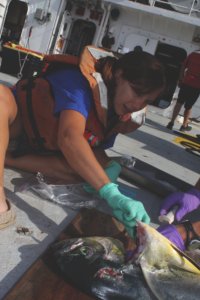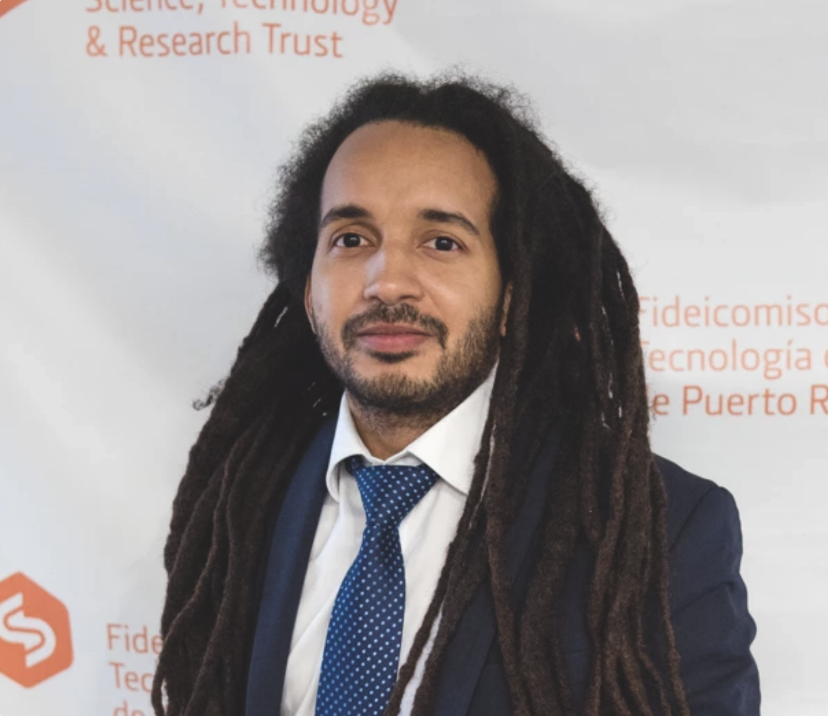Earlier this fall, I attended the Our Ocean conference held by the State Department in Washington, DC. I was fortunate enough to be selected to cover the event on social media and had a first row seat to hear amazing speakers like President Obama, Secretary John Kerry, and other world leaders, and witness global commitments to ocean health.
I was blown away by Dr. Chelsea Rochman’s presentation on plastic pollution in the ocean and caught up with her to talk about her science communication experiences. Chelsea is an Assistant Professor in the Department of Ecology and Evolutionary Biology at the University of Toronto, and her lab focuses on the sources, fate and impacts of plastics and associated chemical contaminants in the environment.

Dr. Chelsea Rochman.
Here are some highlights of my conversation with Chelsea:
What was the topic for your talk?
I was asked to talk about plastic pollution, so I gave an overview of plastic in the ocean, but wove stories in to highlight the important of science in the decision making process. I talked about how I loved science as a child, and took a science job because of the power and utility of the scientific method in informing solutions for policy questions. That was a theme I came back to throughout – science to solutions. Another theme I wove into my talk was the simple question “Where is ‘away’?” because in the US, we throw things ‘away’ and they disappear into landfills and recycling centers, but for other countries, waste is dumped into the backyards of the people in each community. So I talked about how there is truly no ‘away’ but there is a way, or several ways to help mitigate plastic pollution.
There’s always a struggle, when you’re communicating science to inform decisions, in how you talk about solutions without going too far and advocating. At this event, my role was just to discuss the science, so that made it easier. At other events, instead of advocating a particular solution, I talk about all the options for mitigation along the life cycle of plastic.
How did you prepare to speak to this unique audience?
It was a very different audience than I’m used to – and intimidating! I was asked to give a 6-7 minute TED-style talk, which the State Department gave feedback on in advance, to make sure we’d stay in the time limit and not put together the presentation at the last minute on the plane.
The thing that surprised me most at this event, and that was the coolest part, were all the pledges to protect the ocean that countries made. Often with these meetings, you sit around and talk, and then everyone goes home and nothing changes. But Secretary Kerry had asked attendees to come with commitments, and it was really inspiring to see heads of state standing up and saying ‘This is what we’re going to do to protect the oceans.’
What motivates you to talk about your work?
The connection between science and policy that I referenced in my talk has always been important to me—using science to inform policy is huge. I also communicate my science to inspire. I do outreach with kids, and by inspiring them with objective science, I am inspired and re-energized to continue my work.
What science communication tools and resources do you find valuable?
There are lots of science communication books out there, and I’m a Smith Fellow so I’ve attended some trainings through Intermedia Communications.
For this kind of event, I try to make sure I’m telling a full story – starting somewhere and finishing somewhere, not just structuring it like a talk or seminar for work. Start with something personal, a story that relates to yourself, to hook people in and have them see you as a person. I also try to just use good graphics and pictures for my presentation, no words on the slide.
When I’m onstage, I try to use my whole vocal range, and to use pauses to be effective. I also purposefully avoid the podium and try to use body language and eye contact to connect with the audience. When I was younger, I did a lot of acting and improv, and I think there’s a good chance that training helps me still as an academic.
What advice would you give to other scientists interested in engaging?
Never assume that your science isn’t important. Think about how it’s relevant – you care about your research, and others will too. You just have to find the connection.
Start by looking for science communication training opportunities in your institution. If there aren’t any, buy one of the many books on the subject – but to really communicate, you have to practice. Talk about your science to someone who’s not a scientist, with the goal that their eyes don’t glaze over by the end of the conversation. It’s not that our work is boring, it’s that sometimes we don’t make it as accessible as we could.



